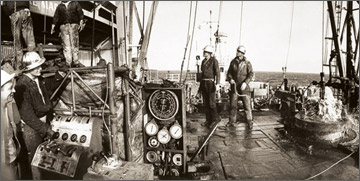Scientists to drill Earth’s mantle
Richard A Lovett
Miles-deep drilling could yield Earth
equivalent of moon rocks, experts say.
|

Ship workers for Project Mohole, a failed attempt to sample
Earth’s mantle in the 1960s. Photograph by Fritz Goro, Time Life
Pictures/Getty Images |
It may not be a journey to the center of the Earth, but it could be
the closest thing yet.
Scientists are planning to drill all the way through the planet’s
miles-thick crust to Earth’s deep, hot mantle and retrieve samples for
the first time. The samples, they say, would rival moon rocks for sheer
scientific import - and be nearly as hard to get.
“That has been a long-term ambition of earth scientists,” geologist
Damon Teagle told National Geographic News.
But a lack of suitable technology and insufficient understanding of
the crust have long tempered that ambition.
Now, better knowledge of the Earth’s shell and technological advances
- for example, a Japanese drill ship equipped with six miles (ten
kilometers) of drilling pipe - have put the goal within reach, according
to a commentary in this week’s issue of the journal Nature, co-written
by Teagle, a geologist at UK’s University of Southampton.
Even so, drilling into the mantle would be ‘very expensive’ and would
require new drillbit and lubricant designs, among other things,
according to the paper.
But if all goes as planned, drilling could begin by 2020, Teagle
said. As soon as next month, the team will begin exploratory missions in
the Pacific, where crews will “bore further into the oceanic crust than
ever before,” the paper says.
Mantle holds clues to quakes and Earth origins
Between Earth’s molten core and hard, thin crust, the roughly
2,000-mile-thick (3,200-kilometer-thick) mantle contains the vast bulk
of Earth’s rocks. But we don’t know much about them, because all we have
are bits that have come to the surface via volcanoes or been trapped in
ancient mountain belts.
But all these mantle samples no longer really represent mantle
conditions and makeup, since they’ve been altered in the long process of
coming to the surface, so they providing only tantalizing glimpses of
what lies below, scientists say.
Drilling would tell scientists not only what the mantle is like, but
also reveal the nature of the Moho layer, a shadowy transitional layer
at the base of the crust.
“We know what happens to seismic waves as they cross the Moho, but we
don’t know what it is,” Teagle said.
Scientists would also be able to look for signs of life in the deep
crustal rocks.
“Wherever we’ve looked, up to 120 °C (248 °F), we’ve seen evidence of
microbial activity,” Teagle said. “We would certainly test that on the
way to the mantle.” But the big prize is the mantle itself.
Getting a sample, he said, would tell us much about the Earth’s
origins and history. Mantle rocks would also provide insight into how
current mantle processes operate - highly important in understanding the
plate tectonics that drive many earthquakes, tsunamis, and eruptions, he
added.
Deep ocean, shallow crust
The best place to drill, Teagle said, is in the mid-ocean, because
that’s where Earth’s crust is thinnest - only about four miles (six
kilometers) thick, versus tens of miles deep in continental regions.
But the mid-ocean, is, of course, still deep - about 2.5 miles (4
kilometers) in the targeted areas. That’s nearly twice the depth
reachable by today’s offshore drilling techniques, Teagle said. So far,
drills have penetrated only about 1.2 miles (2 kilometers) into undersea
crust.
And while the seabed is cold, the drill would have to be able to
reach into a zone where temperatures would hit 570 F (300 C) and
pressures would mount to 2,000 atmospheres - equivalent to more than 4
million pounds per square foot (21 million kilograms per square meter).
“There are deeper drill holes than this,” Teagle said, “but they have
been done on land or into relatively soft sediments.”
There’s no danger of a blowout, such as the Gulf oil spill, because
there are no oil and gas deposits in the mid-ocean for the drill to
accidentally penetrate, he added. Nor would the mantle rocks suddenly
erupt out of the hole, since the channel would be narrow and mantle
rocks aren’t molten.
“There is a risk of failure in that the hole could collapse,” he
said, “but there is no perceived environmental risk.”
National Geographic News
|



